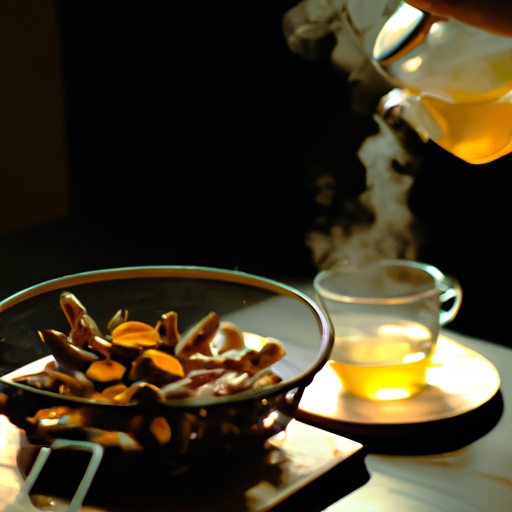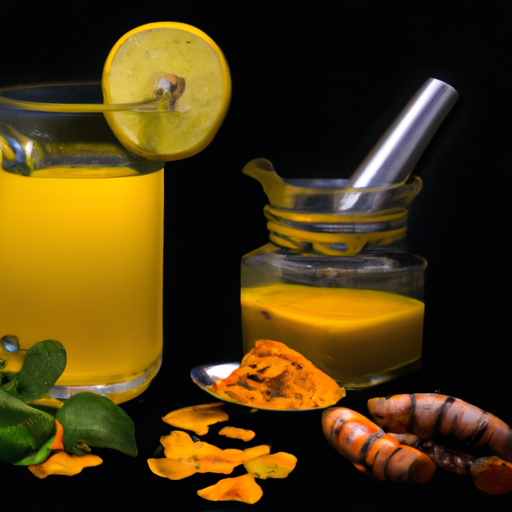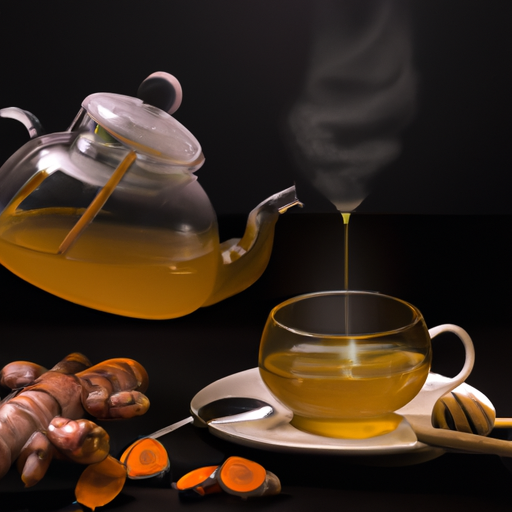I’ve lately come across the numerous advantages of consuming turmeric tea, and I’m thrilled to divulge to you the method I use to prepare a flavorful cup.
Turmeric has been used for centuries in Ayurvedic medicine to treat various ailments, and research has shown that it may have anti-inflammatory and antioxidant properties.
Drinking turmeric tea regularly can also improve digestion, boost immunity, and support healthy skin.
To get started on your own turmeric tea journey, it’s important to select the right type of turmeric.
Look for organic turmeric powder or fresh rhizomes at your local health food store or online retailer.
You’ll also need a few other simple ingredients like water and black pepper (which helps activate the curcumin in turmeric), as well as optional add-ins like honey or ginger for added flavor.
With just a few steps, you can brew a warm and comforting cup of turmeric tea that will nourish your body from the inside out.
Key Takeaways
- Grate fresh turmeric for potent flavor and ensure high-quality tools are used for brewing
- Adding black pepper enhances absorption of curcumin, while optional add-ins like honey, ginger, or lemon can enhance flavor and health benefits
- Consistency is key, with timing and temperature being crucial for optimal brewing
- Storage should be in an airtight container in a cool, dry place away from sunlight, with turmeric tea best consumed within six months for optimal freshness and flavor.
Benefits of Drinking Turmeric Tea
If you’re looking for a way to boost your immune system and reduce inflammation, you’ll love drinking turmeric tea – it’s chock-full of health benefits!
Turmeric tea benefits include its anti-inflammatory properties, which can help relieve joint pain and stiffness. It also contains antioxidants that protect against damage caused by free radicals in the body.
Another benefit of drinking turmeric tea is its ability to improve brain function and lower the risk of brain diseases such as Alzheimer’s disease. Studies have shown that curcumin, the main active ingredient in turmeric, can increase levels of brain-derived neurotrophic factor (BDNF), a protein that helps with the growth and survival of neurons in the brain.
To make turmeric tea at home, try this simple recipe: bring 4 cups of water to a boil and add 1 teaspoon ground turmeric. Reduce heat and let it simmer for 10 minutes. Strain out any remaining particles before serving. But before making your own cuppa, it’s important to select the right type of turmeric.
Selecting the Right Type of Turmeric
Choosing the perfect variety of turmeric can be as overwhelming as picking out a shade of lipstick, but it’s worth the effort to find the right one for your taste buds. There are several types of turmeric available in the market, each with its own unique flavor and aroma. Some popular varieties include Alleppey Finger, Madras Turmeric, and Salem Turmeric.
While all these varieties are beneficial for our health, selecting the right type is essential for brewing a delicious cup of turmeric tea. Turmeric varieties differ not only in their taste but also in their culinary uses. For instance, Alleppey Finger is known for its strong flavor and bright yellow color that makes it ideal for use in curries and pickles. On the other hand, Madras Turmeric has a mild flavor and is commonly used in Indian cuisine to add color to rice dishes and sauces. Similarly, Salem Turmeric has an earthy aroma that pairs well with meat dishes.
Therefore, choosing a variety based on your preferred taste profile will ensure that you enjoy every sip of your turmeric tea. Sourcing turmeric from a trusted supplier is crucial to ensure quality control. Look for organic or non-GMO labels when purchasing turmeric powder or fresh rhizomes to avoid exposure to harmful pesticides or chemicals. Moreover, store turmeric powder in an air-tight container away from direct sunlight to prevent degradation of its natural oils and flavors over time.
By following these tips when selecting your turmeric variety and sourcing high-quality ingredients, you can guarantee a flavorful cup of homemade turmeric tea that’s both healthy and delicious. When it comes to brewing turmeric tea at home, gathering necessary ingredients such as ginger root or honey can enhance both the flavor profile while adding additional health benefits, making this beverage even more enjoyable!
Gathering the Necessary Ingredients
To create a delicious and healthy cup of turmeric-infused beverage, it’s important to gather high-quality ingredients.
Some of the necessary ingredients include honey, ginger root, and fresh turmeric rhizomes. When sourcing for turmeric, it’s best to look for organic or non-GMO varieties that are free from any harmful chemicals. You can also opt for the powdered version if fresh turmeric is not available in your area.
Aside from the ingredients mentioned above, you will also need tea making tools such as a saucepan, strainer, and teapot. Make sure to use high-quality tools to ensure that you can extract the full flavor of the ingredients without any unwanted impurities. As much as possible, avoid using metal utensils as they may react with some of the components in the tea.
With all these necessary ingredients gathered and tools ready to go, we can now proceed with preparing our turmeric tea.
Preparing the Turmeric
First, let’s wash and peel the fresh turmeric rhizomes to prepare them for use in our delicious beverage. Peeling turmeric is similar to peeling ginger root – the skin can be tough and fibrous, so it’s best to use a sharp vegetable peeler or paring knife.
After washing the turmeric thoroughly, I carefully peeled away its outer layer to reveal the bright orange-yellow flesh beneath.
Once the turmeric has been peeled, we have two options for preparing it: grating or powdering. Grating fresh turmeric produces a more potent flavor and aroma than using powdered turmeric, but it can also be messier and more time-consuming. If you choose to grate your turmeric roots, use a fine grater or microplane tool to create small shreds that will infuse well into your tea.
If you’re short on time or don’t have access to fresh turmeric roots, using powdered turmeric is a convenient option. Simply measure out your desired amount of powder (usually 1-2 teaspoons per cup of water) and stir it into your boiling water before steeping. Personally, I prefer using freshly grated turmeric when possible for its robust flavor profile – but whichever method you choose, your homemade turmeric tea is sure to be a tasty treat!
Moving onto boiling the water…
Boiling the Water
Once the pot’s filled with fresh, cold water and set on the stove to heat up, you can hear the gentle hum of anticipation for your soon-to-be warm and comforting beverage. Using the right equipment’s important for brewing a perfect cup of turmeric tea. I like to use a stainless steel pot that has a tight-fitting lid to retain heat and prevent evaporation.
Timing the boiling of the water’s crucial in making turmeric tea. You don’t want to over-boil it as this’ll cause some of the essential oils in turmeric to evaporate, resulting in bitterness. As soon as you see small bubbles forming at the bottom of your pot, turn off the heat and let it sit for about 1-2 minutes before adding any ingredients. This ensures that your water reaches an optimal temperature without overcooking.
Now that we have perfectly boiled water ready, it’s time to add our prepared turmeric root or powder into it!
Adding the Turmeric
Now that the water’s boiling, it’s time to add the turmeric.
The first step is measuring out the desired amount of turmeric powder. I usually use one teaspoon for every cup of water.
Once the turmeric is measured out, stir it into the boiling water until it dissolves completely.
Measuring the Turmeric
To measure the turmeric, you’ll need a teaspoon and a measuring cup. The amount of turmeric you use can vary depending on your personal preference and the recipe you’re following.
For a basic turmeric tea recipe, I recommend using one teaspoon of ground turmeric per cup of water. If you’re experimenting with different variations of turmeric tea recipes, you may want to adjust the amount of turmeric accordingly. Some recipes call for more or less than one teaspoon per cup, so be sure to read through the instructions carefully before measuring out your ingredients.
Once you’ve measured out your desired amount of turmeric, it’s time to move on to stirring the mixture and bringing it to a boil.
Stirring the Mixture
After measuring out the desired amount of turmeric, give the mixture a good stir until it resembles a golden paste that’s smooth as silk. Stirring techniques are crucial when brewing turmeric tea because they affect the consistency and flavor of the final product.
Here are some tips to ensure your mixture is well-stirred:
- Use a whisk or fork to break up any clumps in the turmeric powder.
- Make sure to scrape the sides and bottom of the pot as you stir to incorporate all ingredients evenly.
- Keep stirring for at least 5 minutes or until there are no visible lumps left in the mixture.
- Adjust the heat accordingly while stirring to prevent scorching and maintain an even consistency.
Consistency is key when making turmeric tea, so take your time with this step to achieve a perfectly blended mixture that will result in a delicious cup of tea.
Once your mixture is well-stirred, it’s time to move on to optional add-ins such as honey, ginger, or lemon for extra flavor and health benefits.
Optional Add-ins
You can customize your turmeric tea experience by adding in different ingredients like honey, lemon, or ginger for an extra kick of flavor. Not only do these add-ins enhance the taste of your tea, but they also come with their own set of health benefits.
For example, honey is an excellent natural sweetener that has antibacterial properties and can aid in soothing a sore throat. Lemon is rich in vitamin C and antioxidants that boost the immune system while ginger has anti-inflammatory properties that can help alleviate pain.
When it comes to recipe variations, there are endless possibilities depending on your taste preferences and desired health benefits. You can add a pinch of black pepper to your turmeric tea as it helps enhance the absorption of curcumin, which is the active ingredient in turmeric responsible for its anti-inflammatory effects.
Alternatively, you could try adding cinnamon for a warm and cozy flavor or coconut milk for a creamy texture.
Once you’ve added in your preferred extras to your turmeric tea mixture, allow it to steep for at least 5-10 minutes before straining out any solids. This will give enough time for the flavors to meld together and infuse into the water so that you get maximum enjoyment from every sip.
Now that we’ve covered optional add-ins, let’s move onto allowing the mixture to steep – this step is crucial!
Allowing the Mixture to Steep
Now that I’ve added all the necessary ingredients to my pot, it’s time to let the mixture steep.
Choosing the right steeping time is crucial in making a perfect cup of turmeric tea. It’s important not to over-steep as it can make the tea bitter, and not to under-steep as it won’t extract all the flavors and benefits of the ingredients.
Once the desired steeping time has been reached, straining the mixture is also essential to remove any solids and ensure a smooth drink.
Choosing the Right Steeping Time
Surprisingly, there’s a common misconception that longer steeping time will lead to stronger turmeric flavor in your tea. However, this is not entirely true.
In fact, the longer you steep turmeric tea, the more bitter and astringent it becomes due to the release of tannins. Therefore, choosing the right steeping time is crucial for achieving a perfect balance of flavors.
To determine the ideal steeping time for your turmeric tea, start by adjusting the temperature and experimenting with ratios. Turmeric requires heat in order to release its active compounds into water, but too much heat can cause it to lose its potency and flavor.
As a general rule, aim for a temperature between 185-200°F (85-93°C) and let your tea steep for no more than 5-7 minutes. If you prefer a stronger flavor profile or want to enhance turmeric’s health benefits, consider adding honey or lemon juice instead of increasing steeping time.
With proper attention paid to timing and temperature, you’ll be able to brew an aromatic cup of turmeric tea that tastes smooth on the palate without any bitterness or harshness. Once you’ve reached your desired level of infusion, it’s time to move on to straining the mixture in preparation for serving.
Straining the Mixture
Properly straining the mixture is essential for achieving a smooth and enjoyable cup of this flavorful beverage. Once the tea has steeped for the desired time, it’s time to strain out any remaining solids or particles.
Here are some tips for efficient straining:
-
Use a fine mesh strainer: A fine mesh strainer will catch even the smallest particles, resulting in a smoother texture.
-
Strain twice: For an extra smooth cup of tea, strain the mixture twice using fresh filters each time.
-
Press with a spoon: If some particles remain after straining, use the back of a spoon to press them against the side of the strainer to extract as much liquid as possible.
-
Don’t rush: Take your time when straining and avoid applying too much pressure, as this can result in sediment passing through into your cup.
Aside from digestion benefits, turmeric tea also offers other health benefits such as reducing inflammation and boosting immunity. So, take care when making your tea and enjoy all that turmeric has to offer! Moving onto serving and enjoying…
Serving and Enjoying
Now that my turmeric tea is ready, it’s time to enjoy it!
I always make sure to choose the right mug for my tea. It should be big enough to accommodate the amount of liquid and comfortable to hold.
Once I have my mug, I like to add a splash of milk or cream to give the tea a creamy texture.
Lastly, I sweeten it with honey or maple syrup to taste.
Choosing the Right Mug
To fully enjoy your turmeric tea, grab a cozy mug that fits comfortably in your hands and has a vibrant color to match the golden hue of the tea. Here are some tips for choosing the perfect mug:
- Look for a size that suits your preference, whether it’s a smaller cup for a quick pick-me-up or a larger one for an extended sipping session.
- Consider the material – ceramic or porcelain mugs retain heat better than glass or metal ones.
- Choose a design that matches your decor – from minimalist to whimsical, there are plenty of options out there.
- Check the handle – make sure it’s sturdy enough to hold the weight of the tea without wobbling or burning your fingers.
- Don’t forget about aesthetics – selecting a mug that pleases your eye as well as your taste buds can add an extra layer of enjoyment to your tea-drinking experience.
Now that you’ve found your ideal mug, let’s move on to adding milk or cream.
Adding Milk or Cream
Adding milk or cream can give your turmeric tea a creamy and indulgent flavor. If you prefer a dairy-free option, you can also use alternative milks such as almond, coconut, or soy milk. These non-dairy options are great for those who are lactose intolerant or vegan.
When adding milk or cream to your turmeric tea, it’s important to note that it may affect the spice level. The fat in the milk or cream can lessen the intensity of the spices, so you may need to adjust the amount of turmeric and ginger accordingly. You can start by adding a small amount of milk or cream and gradually increasing until you reach your desired taste.
To sweeten your turmeric tea to taste, simply add honey or any other natural sweetener that you prefer. This’ll give your tea a deliciously sweet flavor without overpowering the earthy taste of turmeric and ginger.
Sweetening to Taste
You might be hesitant to sweeten your turmeric drink, but a small amount of honey or natural sweetener can enhance the flavors without making it too sugary. Some great options for natural sweeteners include raw honey, maple syrup, or stevia. These sugar alternatives have a lower glycemic index than regular sugar and provide additional health benefits.
To help you choose the right sweetener for your taste buds, here is a table outlining the taste and benefits of some common natural sweeteners:
| Sweetener | Taste | Benefits |
|---|---|---|
| Raw Honey | Sweet with floral notes | Contains antioxidants and antibacterial properties |
| Maple Syrup | Earthy sweetness with hints of caramel | Rich in minerals such as iron and zinc |
| Stevia | Very sweet with slight licorice flavor | Zero calories and doesn’t spike blood sugar levels |
Adding just a small amount of one of these natural sweeteners can make a big difference in enhancing the flavor profile of your turmeric tea while also providing added health benefits. As you experiment with different amounts and types of sweeteners, remember to keep it balanced so that it doesn’t overpower the other flavors present in the tea.
When it comes to storing and reheating your leftover turmeric tea, there are certain steps you can take to ensure its freshness.
Storing and Reheating
When storing turmeric tea, it’s important to keep it in an airtight container to maintain its freshness. Exposure to air can lead to the tea losing its potency and flavor over time. It’s also worth noting that turmeric has natural antibacterial properties, so keeping the tea in an airtight container prevents any unwanted bacteria from entering.
To ensure that your turmeric tea stays fresh for as long as possible, consider these three storing tips:
-
Store in a cool, dry place: Moisture can cause the tea leaves to clump together and lose their flavor, so it’s best to store them in a cool, dry place like a pantry or cupboard.
-
Keep away from sunlight: Sunlight can speed up oxidation and damage the quality of the tea leaves. Make sure to store your turmeric tea away from direct sunlight or any other sources of heat.
-
Use within 6 months: While turmeric tea may last longer than six months if stored properly, it’s generally recommended that you use it within this timeframe for optimal freshness and flavor.
When reheating your stored turmeric tea, there are a few techniques you can try:
-
Microwave: Simply pour your desired amount of cold turmeric tea into a microwave-safe container and heat on high for 30-60 seconds depending on your microwave wattage.
-
Stovetop: Pour your desired amount of cold turmeric tea into a saucepan and gently heat over low-medium heat until warmed through.
-
Cold brew: If you prefer not to reheat your stored turmeric tea at all, try making cold-brewed iced turmeric tea instead by steeping the leaves overnight in cold water and serving over ice with lemon wedges for added flavor.
Frequently Asked Questions
Is there a recommended time of day to drink turmeric tea for maximum health benefits?
According to recent studies, drinking turmeric tea can significantly boost your overall health and well-being. Many experts recommend consuming it in the morning or early afternoon for maximum health benefits. This is because turmeric contains antioxidants and anti-inflammatory compounds that can help reduce inflammation and improve digestion throughout the day.
However, it’s important to note that everyone’s body is different and what works best for one person may not work as well for another. Ultimately, the most important thing is to listen to your body and consume turmeric tea at a time that feels right for you.
Can turmeric tea be made with powdered turmeric instead of fresh turmeric root?
Yes, powdered turmeric can be used to make turmeric tea. In fact, many people prefer using the powder because it’s more convenient and easier to find in stores than fresh turmeric root.
To make a cup of powdered turmeric tea, simply add 1-2 teaspoons of the powder into hot water and stir until it dissolves. You can also add other spices such as ginger or cinnamon for added flavor and health benefits.
There are many variations of turmeric tea that incorporate different ingredients depending on individual preferences and needs, but using powdered turmeric is a great place to start.
How long does the turmeric need to be boiled for before adding it to the water?
When boiling turmeric for tea, the recommended time varies depending on whether you’re using fresh or powdered turmeric. If using fresh turmeric root, it should be boiled for at least 15-20 minutes to release its full flavor and potential health benefits.
However, with powdered turmeric, boiling for only a few minutes is sufficient as it’s already been processed and ground. It’s important to note that consuming too much turmeric can lead to side effects such as stomach upset or interference with certain medications.
Additionally, pre-made storage of turmeric tea can lead to flavor variations over time. Therefore, it’s best to make small batches of fresh turmeric tea as needed for optimal taste and health benefits.
Are there any potential side effects of drinking turmeric tea?
When it comes to potential side effects of drinking turmeric tea, there are a few things to keep in mind. While turmeric is generally considered safe for most people when used in culinary amounts or when taken orally as a supplement, some people may experience stomach upset, nausea, or diarrhea.
Additionally, high doses of turmeric may cause liver problems and interact with certain medications such as blood thinners. However, despite these potential side effects, there are also many health benefits associated with consuming turmeric tea.
Turmeric contains compounds that have anti-inflammatory and antioxidant properties which can help reduce inflammation in the body and protect against chronic diseases like cancer and heart disease. It’s important to note that while turmeric can be beneficial for some people, it’s always a good idea to consult with a healthcare provider before adding any new supplements or foods to your diet – especially if you’re taking medications or have underlying health conditions.
Can turmeric tea be made ahead of time and stored in the refrigerator?
Listen up, tea lovers! I’ve got some great news for you. Yes, you can totally make turmeric tea ahead of time and store it in the refrigerator.
In fact, making a large batch of this vibrant brew is a smart move if you’re short on time or want to enjoy it throughout the week. To ensure that your turmeric tea stays fresh and flavorful, I recommend storing it in an airtight container or Mason jar in the fridge for up to three days.
When you’re ready to drink it, simply reheat the desired amount on the stove or in the microwave until steaming hot. Make ahead options like these are not only convenient but also save precious time when you need it most.
So go ahead and brew yourself a big ol’ batch of turmeric tea—your future self will thank you!
Conclusion
In conclusion, brewing turmeric tea is a simple and enjoyable way to reap the many health benefits of this powerful spice. Anyone can create a delicious and nutritious beverage that supports digestion, reduces inflammation, and boosts overall wellbeing by selecting high-quality turmeric and following the steps outlined above.
Some may argue that turmeric tea has a strong flavor that can be difficult to enjoy, but it’s easy to customize the taste to suit personal preferences by experimenting with different add-ins such as honey or lemon juice. Plus, the potential health benefits make it well worth incorporating into your daily routine. So why not give it a try?
Your body will thank you for it!










